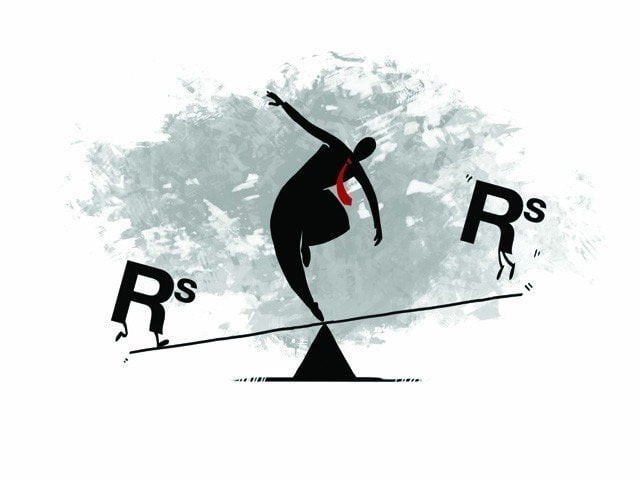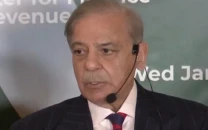Rs1.8 trillion earmarked to service mountain of debt
This spending is close to half of the federal budget outlay of Rs4.394 trillion.

This spending is close to half of the federal budget outlay of Rs4.394 trillion. ILLUSTRATION: JAMAL KHURSHID
The spending is also greater than the total federal and provincial development allocations, which are of Rs1.67 trillion. Under the Public Sector Development Programme (PSDP), the federal government will spend Rs800 billion while the provinces are allocated Rs875 billion.
The government had set a target of Rs1.596 trillion during the outgoing financial year 2015-16 but this target was revised upwards to Rs1.63 trillion due to increase in borrowing.
On foreign debt servicing (interest payment), the country will expend Rs113 billion, while on foreign loan repayment (or principal amount) Rs443.807 billion will be spent. On domestic debt servicing, the economy will consume Rs1.2 trillion.
During the outgoing fiscal 2015-16, revised estimates on public debt servicing (paying interest and principal amount), the government spent a huge Rs1.63 trillion against the budgeted Rs1.596 trillion.
Economists believe that even though the government has been boasting of increasing foreign exchange reserves, the pressure on the reserves will build with huge debt servicing requirement in the coming months.

They are of the view that government will be seeking more foreign loans to retire public debt in future and the economy will not be able to bear the burden of the debt pile.
Economic assistance
According to budget document, the government has revised estimates of foreign assistance, which include Rs304.72 million from United States under Kerry Lugar. But there will be no assistance from the US under this head during the next financial year.
The government has estimated an increase of Rs819.6 billion in the foreign assistance in 2016-17 against the outgoing fiscal year’s Rs775.26 billion, which was later revised upward to Rs859.688 – the rise attributable to loans from commercial banks.
The external resources for 2016-17 have been projected at Rs819.6 billion which is lower by 5 per cent than the revised estimates of 2015-16 but 6 per cent higher than the budget estimates of 2015-16.
The government has estimated an assistance of Rs60.378 billion from China in 2016-17 against Rs85.934 billion of 2015-16, which was later revised to Rs144.454 billion. The government has estimated a significant Rs211.52 billion assistance from commercial banks for 2016-17.
Under the head of loans, Rs796.78 billion has been estimated for 2016-17 against the outgoing fiscal year’s budgeted estimates of Rs750.14 billion, which were later revised to Rs821.42 billion.
The government has budgeted Rs22.81 billion under the head of grants for next fiscal year against Rs25.11 billion budgeted for 2015-16, which was later revised upward to Rs38.24 billion.
From sovereign bonds, the government has estimated Rs105.5 billion against the outgoing year’s Rs101.25 billion, which was revised to 52.2 billion.
No amount has been estimated under the head of Kerry Lugar. No amount was budgeted under the head in the outgoing financial year; however, the estimate was later revised to Rs304 million.
The government has estimated Rs79.125 billion from Sukuk Bond while no amount was budgeted under this head in 2015-16. From Islamic Development Bank, the government has budgeted Rs49.67 billion against Rs127.45 billion for the outgoing fiscal year, which was later revised to Rs114.67 billion.
The government has budgeted Rs110.585 billion from Asian Development Bank (ADB) against Rs103.31 billion for the outgoing financial year which was later revised to Rs133.95 billion.
Published in The Express Tribune, June 4th, 2016.



















COMMENTS
Comments are moderated and generally will be posted if they are on-topic and not abusive.
For more information, please see our Comments FAQ